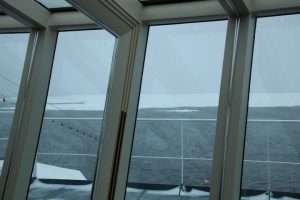We are still in Lancaster Sound at 74° 18´ North, 82° 01´ West. We are surrounded by floes of sea ice and enveloped in sea fog. We have spent the night here and were woken by the bow thrusters turning the ship into the wind just before 08:00. We came here last evening after receiving the news that the expedition leaders think that the ice is too thick for us to continue. There is great disappointment that since leaving Dundas Harbour several days ago that there seems to be little attempt to even try for such places as Beechey Island. Clearly the Captain is responsible for his ship but we are now just filling in time. We have a new airlift planned from Pond Inlet to Resolute Bay and then on to Montreal, but this is likely to be at night seeing us arrive at the hotel early in the morning of the 11th.
Lancaster Sound was named in 1616 by the explorer William Baffin after Sir James Lancaster who was one of the sponsors of his earlier explorations.
The cargo ship in the above photographs is navigating the main entrance from the east of the route followed by all of the explorers from Europe. It is in this area that the mystery of the disappearance of the Franklin Expedition is centred. In 1845 Sir John Franklin persuaded the Admiralty to let him lead another expedition to find the final missing link in the Northwest Passage i.e. the route into the Beaufort Sea. He left Greenhithe, London, on 19th May 1845. In 1846 the ships Erebus and Terror were trapped by heavy sea ice off the northwest coast of King William Island to the west of where we are now. A note that describes this entrapment was left in a stone cairn at Victory Point. It is dated 1847. Shortly after the death of Franklin which was thought to be 11th June. The cause of his death and the whereabouts of his body remain unknown at this time because archaeological work continues and with DNA they can find to whom the bones belong.
The Belgian artist F.E. Mussin’s 1846 depiction of the Erebus surrounded by ice.
British artist W. T. Smith’s depiction of Franklin and his crew dying alongside their boat. Both of these are to be found in the book Finding Franklin.
The photograph of the note shows that someone else had found it and annotated details of this. It was found in this condition by the McClintock Expedition to find Franklin in 1859 and there is still debate as to the reliability of these notes.
Source: Finding Franklin
By 1850 the Admiralty launched full scale searches and these expanded the knowledge of the region and improved the maps. In 1854 the Scottish fur trader working for the Hudson’s Bay Company, John Rae, was already familiar with overland explorations as part of his work. He approached the region from the southwest and spoke to and used techniques from the Inuit peoples. It is through these encounters that he provided the first account describing dozens of white men dying at what is now named Starvation Cove. It is thought by many historians that Rae is most likely to have been the first to navigate the passage but his report to the Admiralty was discredited by them and even leaked to the Times newspaper who published the most shocking revelations of cannibalism amongst the surviving men. This debate also continues with one author J.B. Latta claiming that there was a conspiracy that covered up and betrayed Franklin and all the private expeditions to find him. Was this covering up the Admiralty’s intransigence to accept help and advice from indigenous people? This was repeated with Scott’s failed mission to be first to the South Pole.
Source: Finding Franklin
The 1903-5 success of Amundsen in claiming the passage was clearly a product of all of the previous expeditions, their findings and mappings.
During the morning a few passengers made a landing on an ice floe. According to one person it was very cold and the horizontal snow coupled with the wind made her cheeks feel as if they had been sandpapered. By the afternoon the very small flakes of snow had accumulated on the ship. (Deck 7) We are currently making our out of the Lancaster Sound into warmer waters.










